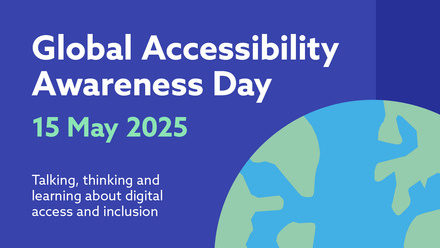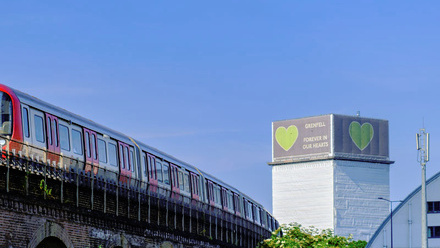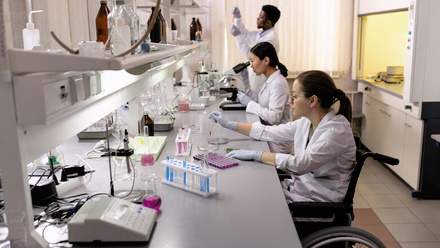The art of 'real research'
Materials science researcher turned secondary school Physics teacher Dr James Perkins chats to Materials World about a unique offering that allows students to get involved in research projects.

It is very rare for schoolchildren to see a state-of-the-art electron microscope, let alone get to use one.
So, when Physics teacher Dr James Perkins managed to secure a TM3000plus table-top scanning electron microscope (SEM) for St Paul’s School in Barnes, Southwest London, UK, in 2014, the secondary students were in the enviable position of being able to undertake scientific research that their peers could only dream of.
It is one of the fascinating steps along Perkins’ eventful journey working in STEM outreach and a career that began in academia.
'My love of science took me via a Physics degree into materials science research with a PhD under Professor Mike Lewis at Warwick University and then in Professor David McComb’s group at Imperial College,' explains Perkins.
'During my time in academia, more and more I realised that as much as I loved my work, it was teaching and communicating science that really inspired me. My aim of moving into teaching was to be able to bring the joy of research to secondary students and joining St Paul’s School was the perfect move to support the idea.'
Perkins, who is now Head of the Science faculty at Queen Elizabeth’s Grammar School in Faversham, Kent, had been inspired from an early age when one of his own school teachers, Professor Becky Parker, went on to set up the Institute for Research in Schools (IRIS).
The institute’s aim is to develop opportunities for secondary students and post-16s from all backgrounds to participate in authentic research and make valuable recognised contributions to the scientific community.
It was exactly what Perkins wanted the SEM to be available for. The objective is not just to demonstrate the technology, but for secondary students to receive training from and work with professional scientists so they can use the equipment for their studies.
Since the first SEM arrived at St Paul’s School, with financial help from the Worshipful Company of Armourers and Braziers, Perkins has been working on a project with Hitachi High-Tech America to bring more table-top electron microscopes to the UK. Around £100,000-worth of research equipment will now be loaned to schools for in-person or remote access during term time for research projects, curriculum enhancement and outreach events.
On the table
The idea came about when Perkins was awarded a Winston Churchill Memorial Trust (WCMT) Fellowship in 2015.
Through this, he was able to fund a research expedition to the USA, Canada and Germany to look at how innovative research equipment and expertise was being used at the equivalent secondary school level.
'This was incredibly important in understanding how some really keen teachers and schools have been able to tap into the ‘forgotten middle’ students who might not be the high flyers, but who really get their teeth into independent research projects and can achieve great outcomes,' he says.
Perkins produced a report on his findings. Bob Gordon, Senior Executive of Hitachi High-Tech America’s Inspire STEM Education Outreach Program's global outreach, read it and got in touch.
The Japanese technology giant runs a STEM inspire programme and Gordon realised that its use of table-top microscopes in American schools was a model that could work equally well in the UK.
Around the same time, Perkins had been asked to join the Royal Microscopical Society’s (RMS) education and outreach committee where he met Dr Alex Ball, Head of Division at the Natural History Museum’s Imaging and Analysis Centre. Ball would become a key collaborator on the SEM project at St Paul’s School, advising on its use.
Together, they began exploring the options around creating UK-wide outreach activities and co-designed a nationwide SEM loan project.
'The RMS has a fantastic programme with the microscope activity kits for primary schools,' says Perkins.
'Obviously £100k worth of equipment is not straightforward to get hold of, but Hitachi High-Tech America have the perfect instrument and were keen to make the project happen. Tying together the various elements, logistics, proposals, training, tech support and so on was the difficult bit.'
The magic of materials
During the school holidays, two microscopes will be hosted at the Natural History Museum’s Angela Marmont Centre (AMC) for UK Biodiversity.
'This is key to the project as it opens up the opportunity for amateur scientists as well as schools that may not be able to host a SEM directly,' explains Perkins. 'With remote operation available, schools can collaborate as well as work with the experts at the AMC.'
During term-time, the SEMs will be rotated around different schools, which will need to submit a brief proposal to IRIS outlining what they intend to do with it.
As Perkins notes, this could be anything from investigating or showcasing the technology through to original research projects, as well as STEM clubs, science events, school networks and collaborations.
'The expert panel [at IRIS] will give feedback on the proposals and put schools in touch with relevant academics, ideally in their location,' he adds.
The project also builds on previous long-standing STEM outreach programmes in biology, chemistry and materials science, which have been running since 2013.
As Perkins explains, St Paul's was actively recruiting from academia and it was his then employers’ 'forward-thinking approach' to STEM that enabled him to set up Saturday schools for local state schoolchildren. Each session would deliver a different materials science theme.
'This was incredibly popular and led me to seek out Dr Diane Aston, [Head of Education and Professional Development] from the Institute of Materials, Minerals and Mining (IOM3) to help set up a residential summer school – the Magic of Materials course,' he says.
Open to non-fee-paying school pupils from across the UK, the three-day course, which is organised and run in partnership between St Paul’s and IOM3, first ran in July 2016.
The ground-breaking course gives students aged 13-14 the opportunity to explore materials beyond the confines of the curriculum, participating in a series of lab classes, lectures and workshops led by teachers, academics and industry experts.
Perkins adds, 'I'm really proud of this course. We're starting to see the outcomes of our first cohort and the PhD/Postdoc mentors have, in many cases, continued to work with young people.'
Under the microscope
As successful as all this work has been, Perkins notes that engaging young people in STEM remains a challenge.
'What I’ve seen in the past three years is the gradual change as students focus on other things,' he says. 'We are all scientists and the phrase coined by Professor Louise Archer – ‘science capital’ – is absolutely key. As children find their own interests, it is important that they continue to be polymaths, interested in all areas of learning.'
Perkins doesn’t believe that asking young students to focus their energies on competing against other subjects at school is helpful.
That’s why he says independent research projects that involve multiple disciplines, such as communication, networking, teamwork and collaboration, supported by an understanding of the science context, will produce better informed and skilled school leavers. It also encourages those students who may not have thought of the sciences as a pathway to keep that door open.
'It’s about maintaining a range of options rather than closing the door to a particular field of study.'
Discover more about Hitachi High-Tech America's Inspire STEM Educational Outreach Program.
Supporting 5-19 education
IOM3 is committed to supporting the teaching of the materials, minerals and mining topics in the science, geology, design technology and engineering curricula and promoting careers in STEM as exciting, challenging and rewarding. We have a suite of resources for learners and teachers from primary school upwards. These include lesson plans, worksheets and presentations, physical handling collections, and once we can run them again, opportunities for face-to-face interactions. We are working with partners like James Perkins, St Paul’s School, the Discover Materials initiative, and our own communities to increase the quantity and impact of our interactions with young people.
For more information, visit our education pages.







